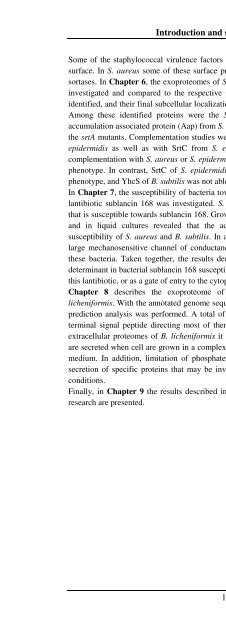The Staphylococcus aureus secretome - TI Pharma
The Staphylococcus aureus secretome - TI Pharma
The Staphylococcus aureus secretome - TI Pharma
You also want an ePaper? Increase the reach of your titles
YUMPU automatically turns print PDFs into web optimized ePapers that Google loves.
Introduction and scope of this thesis<br />
Some of the staphylococcal virulence factors are proteins that are displayed at the cell wall<br />
surface. In S. <strong>aureus</strong> some of these surface proteins are linked to the cell wall by so-called<br />
sortases. In Chapter 6, the exoproteomes of S. <strong>aureus</strong> and S. epidermidis srtA mutants were<br />
investigated and compared to the respective parental strains. Several SrtA substrates were<br />
identified, and their final subcellular localization was found to be altered in the srtA mutants.<br />
Among these identified proteins were the S. <strong>aureus</strong> surface protein G (SasG) and the<br />
accumulation associated protein (Aap) from S. epidermidis. Biofilm formation was affected in<br />
the srtA mutants. Complementation studies were performed with SrtA from S. <strong>aureus</strong> and S.<br />
epidermidis as well as with SrtC from S. epidermidis and YhcS from B. subtilis. Only<br />
complementation with S. <strong>aureus</strong> or S. epidermidis SrtA resulted in restoration of the parental<br />
phenotype. In contrast, SrtC of S. epidermidis only partially seems to restore the parental<br />
phenotype, and YhcS of B. subtilis was not able to complement for the loss of SrtA at all.<br />
In Chapter 7, the susceptibility of bacteria towards the extremely stable and broad-spectrum<br />
lantibiotic sublancin 168 was investigated. S. <strong>aureus</strong> is one of several important pathogens<br />
that is susceptible towards sublancin 168. Growth inhibition and competition assays on plates<br />
and in liquid cultures revealed that the addition of NaCl lowered the sublancin 168<br />
susceptibility of S. <strong>aureus</strong> and B. subtilis. In addition, it was shown that the presence of the<br />
large mechanosensitive channel of conductance MscL is important for the susceptibility of<br />
these bacteria. Taken together, the results demonstrate that MscL is a critical and specific<br />
determinant in bacterial sublancin 168 susceptibility that may either serve as a direct target for<br />
this lantibiotic, or as a gate of entry to the cytoplasm.<br />
Chapter 8 describes the exoproteome of the commercially interesting organism B.<br />
licheniformis. With the annotated genome sequence of B. licheniformis DSM 13, a <strong>secretome</strong><br />
prediction analysis was performed. A total of 296 proteins were predicted to contain an Nterminal<br />
signal peptide directing most of them into the Sec pathway. From analysis of the<br />
extracellular proteomes of B. licheniformis it was concluded that higher amounts of protein<br />
are secreted when cell are grown in a complex medium compared to cell grown in a minimal<br />
medium. In addition, limitation of phosphate, carbon and nitrogen sources resulted in the<br />
secretion of specific proteins that may be involved in counteracting the imposed starvation<br />
conditions.<br />
Finally, in Chapter 9 the results described in this thesis are discussed and ideas for future<br />
research are presented.<br />
13













